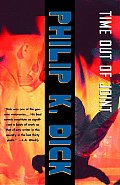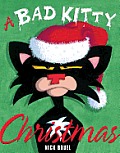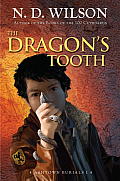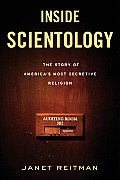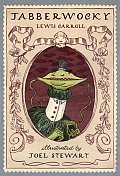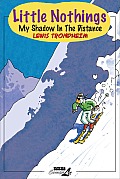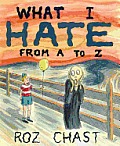Link to this review in the form of a comic strip by billba tagged science fiction
Link to this review by gigi tagged picture book • humor
It’s Christmas. When Bad Kitty’s owner wakes up, he finds her covered in wrapping paper. Bad Kitty had done some bad things like flinging fruitcake and ambushing the angel on the top of the tree. Bad Kitty was going to get wonderful presents but she ripped them all up. She refuses to help clean up. When the family goes to visit Uncle Murray, Bad Kitty jumps out of the car and runs away. Puppy follows her.
Why I picked it up: I liked the other Bad Kitty books a lot. (Happy Birthday, Bad Kitty is my favorite.)
Why I finished it: I liked the part when Bad Kitty thinks about what she wanted for Christmas. It’s a list of animals in alphabetical order, combined in different dishes like “A Narwhal. An Owl. And a Penguin on rye.”
I’d give it to: My Great Aunt Jane. She’s like the old lady who takes Bad Kitty in and feeds her because she saves stray cats, too.
Link to this review by flemtastic tagged thriller • fantasy
Antigone and Cyrus have lived with their older brother, Daniel, in a decrepit motel for years. Things are boring until the arrival of a man with bones tattooed all over his body. He demands a room, and dies there soon after, leaving the motel on fire, Daniel missing, and Cyrus and Antigone on the run with a set of keys that can open any lock.
The other occupants of Ashtown despise them for crimes their parents committed. They must keep Ashtown from being taken over by Dr. Phoenix, a villain who can become a giant ape known as Mr. Ashes and who will stop at nothing to get the keys.
Why I picked it up: I’m always looking for good middle-grade fantasy, but I also thought this would be good because N. D. Wilson is famous for the 100 Cupboards books.
Why I finished it: Action! There is never a dull moment, plus there are neat details about magical items I had not seen before, like Quick Water. (It’s breakable water, and each piece acts as a lens for remote viewing.) Also, the kids are distrusted from the first moment they step into Ashtown, and are primed to fail. After joining the Order of Brendan, Antigone and Cyrus are given the deepest rooms in a decrepit building where they share living quarters with an immortal ghost thief and many Whip Spiders (scorpion-like creatures that attack anything that falls off the suspended plank pathways and hits the ground).
I’d give it to: Alex, who would like the breakneck pace and also the weaponry — one bad guy fires a gun that shoots fireballs that take out the motel with one shot! Jace, who would like that the reader never knows who the kids can trust as they attempt to keep the keys safe from people who want to use them to release the immortal prisoners held in Ashtown.
Link to this review by flemtastic tagged history
Janet Reitman began researching Scientology for an article in Rolling Stone that was a finalist for the National Magazine Award in 2007. She continued digging until she had invested five years of research into this book. It begins with L. Ron Hubbard’s childhood and early writing career, then really picks up speed when he conceives of making his book, Dianetics, into a religion called Scientology. The basis of Scientology is that believers attempt to evolve up a Bridge by doing auditing sessions: while hooked up to an E-Meter (a rudimentary sort of lie-detector), a person talks about a disturbing event (an Engram) in his/her past. If the E-Meter doesn’t fluctuate, they have overcome or passed that level. The ultimate goal is to become Clear, with no Engrams to block a Scientologist’s progression up the Bridge.
Reitman shows Hubbard to be a magnetic personality whose biggest talent may have been revising his personal history; people who listened to his claims often replied that twenty busy men would never have had time to do everything he said he had. While there is plenty of salacious material about gun-toting guards, efforts to pull in pampered celebrities who would bring positive press to Scientology, and rumors about Hubbard’s lessons about how we descended from space aliens, Reitman reports coolly and factually, letting readers make up their own minds.
Why I picked it up: I heard Reitman’s book mentioned on the radio. I remember taking a free Scientology personality test while I was a university student. Afterward, I was told I had some serious issues to work on! (Editor’s note: That’s true. :) )
Why I finished it: When L. Ron Hubbard died, the church said that his research had taken him beyond the bonds of his human body, which he did not need anymore. I was astonished to see that the church celebrated his ascendance instead of questioning why Hubbard lived, overweight and on psychiatric drugs (which the church rails against), at a secret desert compound for the last seven years of his life, from where he issued regular bulletins on how everyone should behave. (Those who transgressed his rules were subject to fourteen-hour workdays, rice and beans meals, and daily sessions to discover the weaknesses that were making them enemies of Scientology.)
I’d give it to: Jonathan, who would be shocked to hear the level of dedication that believers in Scientology’s top division, the SeaOrg, were required to demonstrate, including signing a billion-year contract to serve the church in all future lives.
Link to this review by billba tagged picture book • poetry
A boy goes to slay a monster in this poem from Alice in Wonderland. (Several of its many made-up words (like “chortle”) have entered the general lexicon, but I first heard “Frumius Bandersnatch” as the name of an alien monster in Larry Niven’s Known Space series.)
Why I picked it up: It was a gift to my son Theo from his Nana when he was a toddler. Ironically, she hates weapons, but this is the book in which he learned all about swords via the awesome “Snicker-Snack” scene in which the Vorpal Blade is deployed with devastating effect.
Why I finished it: The genius of these watercolor and ink illustrations is that they are cute and a little scary, with a biomechanical monster and old-fashioned Wanted posters warning the boy to Beware the Jabberwock.
I’d give it to: Rowan, who follows Theo around at homeschool Park Day, wanting to be just like him. Callooh! Callay!
Link to this review by sarahhunt tagged picture book
Years after losing her baby teeth, Lee gets an unexpected guest: ickle, one of her baby teeth, has returned! He, and later arrival Lardee, have childlike adventures around her apartment.
Why I picked it up: I’m willing to take a chance on any book with the word “toof” in the title.
Why I finished it: ickle arrives with a tiny cloth cap and and a library of tiny books (“You can borrow these if you like,” says ickle after putting them away) and Lardee arrives with an itty bitty red book bag. The book is filled with delightful interactions between the teeth, their toys, and their otherwise human-scale surroundings: playing, baking cupcakes, or trying to take a phone message. I wish I could play with the props all day.
I’d give it to: Graham, who can enjoy this gorgeously-crafted photo comic while his kids enjoy the teeth’s realistic older sibling/younger sibling trouble.
(See more of the teeth’s photo adventures on Inhae Lee’s blog.)
Link to this review by geneambaum tagged graphic novel • biography
Full-color, anthropomorphic, autobiographical comics by Trondheim, most of which are about travel and aging.
Why I picked it up: I read everything by Trondheim that’s available in English. But I would have picked this up for the cover alone — Trondheim is skiing down a snow-covered mountain, but when he looks at his shadow, he can see the shape of the monstrous avalanche behind him.
Why I finished it: Trondheim documents travel-related absurdities the likes of which I’ve encountered: the long lines for a brief glimpse from the Empire State Building, the weird look from a rental car agent when he turned down the extra insurance, and trouble figuring out how to turn on a faucet. But my favorite strip in the collection is when he contemplates the miniature soccer ball and goal he finds in a urinal.
I’d give it to: My hypochondriac friend, Richard. He’d enjoy (and be haunted by) the health problem Trondheim develops in Prague. The treatment he receives is borderline surreal, and later, during an exam, a doctor offers to show him his nasal polyps (he declines).
Link to this review by geneambaum tagged historical fiction • graphic novel
Houston, Texas, 1968. Jack Long works as TV station KRRC’s race reporter. After the Dean of Students doesn’t approve the Friends of the Student Nonviolent Coordinating Committee (SNCC) as an on-campus group, the demonstrators seem like they’re going to turn on Jack, who is filming a story. But Larry vouches for him, and helps him get the story. Jack and Larry form a friendship across well-established color lines as Jack continues to try reporting on an SNCC demonstrator put on trial for verbally threatening a police officer (the man is charged with attempted murder and faces the death penalty).
Why I picked it up: Jim’s a friend, and I’m a huge fan of Nate Powell’s work. I couldn’t wait to read it.
Why I finished it: It really brought home the casual racism of the era, and the difficulty of overcoming it. A clan rally flier is left on Jack’s door, but more disturbing is that his son goes “nigger knocking” in their neighborhood, and the racist taunts of his son’s friends. After Larry saves Jack from the demonstrators, Jack says, “I’m sure there’s a lot of razors in those shoes.” But after Larry points out SNCC is nonviolent, Jack apologizes: “That’s something my mother used to say.” Jack, Larry, and their families do their best to bridge the social gap, even bringing their families together, which makes for an awkward situation until they bond over music.
I’d give it to: The County Line, the tavern where my father used to hang out, by leaving it on the bar. I went in there twice, the last time with my wife. I’d told her how horrible it was, how racist and ignorant my father and his friends were. She thought I was exaggerating. But after one joke too many, she turned to me and said, in Korean, “If I weren’t here they’d be talking about me, too, wouldn’t they.” (Unfortunately, like most important books, I’m not sure the folks who need to read it ever would. But maybe I’d tell the story of Jack’s drunk friend just to get someone to pick it up.)
Link to this review by dawnrutherford tagged picture book • humor
Artist Roz Chast’s anxiety manifests itself in a variety of ways, big and small. She made an alphabet book featuring twenty-six things that cause it.
Why I picked it up: I’ve really enjoyed Chast’s cartoons since I first saw them in The New Yorker. They have a raw, frazzled quality that really embodies her angst.
Why I finished it: Like one of my all time favorite books on the subject, The Pop-Up Book of Phobias, Chast covers the classics (flying, clowns, illness) and includes lots of things that either freaked me out when I was a kid (spontaneous human combustion) or still freak me out (general anesthesia). Not only did her illustrations make me feel her trepidation, she also explained why each scares her as an adult, with an honesty most folks can’t muster.
I’d give it to: Sharyn, who has really tempered back her rants about what she dislikes, but would enjoy reading Chast go off on kites and tunnels.
